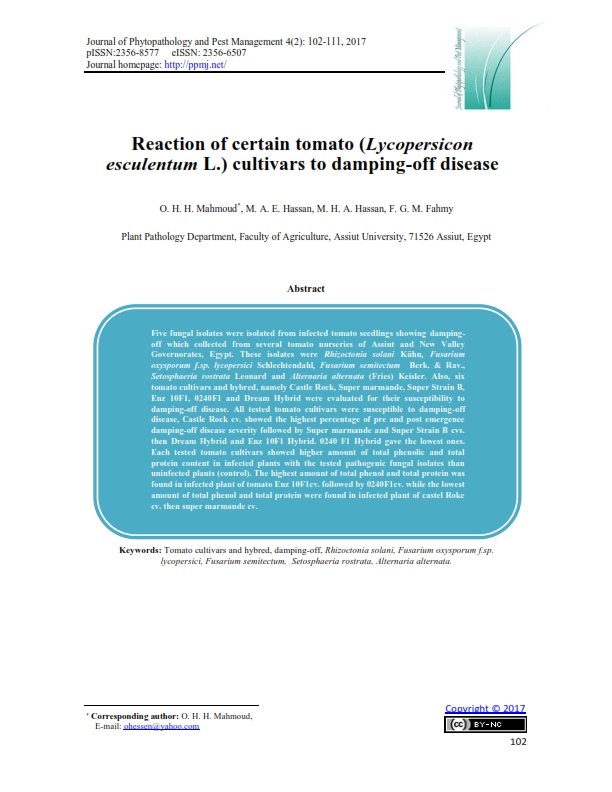Reaction of certain tomato (Lycopersicon esculentum L.) cultivars to damping-off disease
Mots-clés :
Tomato cultivars and hybred, damping-off, Rhizoctonia solani, Fusarium oxysporum f.sp. lycopersici, Fusarium semitectum, Setosphaeria rostrata, Alternaria alternataRésumé
Five fungal isolates were isolated from infected tomato seedlings showing dampingoff which collected from several tomato nurseries of Assiut and New Valley Governorates, Egypt. These isolates were Rhizoctonia solani Kühn, Fusarium oxysporum f.sp. lycopersici Schlechtendahl, Fusarium semitectum Berk. & Rav., Setosphaeria rostrata Leonard and Alternaria alternata (Fries) Keisler. Also, six tomato cultivars and hybred, namely Castle Rock, Super marmande, Super Strain B, Enz 10F1, 0240F1 and Dream Hybrid were evaluated for their susceptibility to damping-off disease. All tested tomato cultivars were susceptible to damping-off disease, Castle Rock cv. showed the highest percentage of pre and post emergence damping-off disease severity followed by Super marmande and Super Strain B cvs. then Dream Hybrid and Enz 10F1 Hybrid. 0240 F1 Hybrid gave the lowest ones. Each tested tomato cultivars showed higher amount of total phenolic and total protein content in infected plants with the tested pathogenic fungal isolates than uninfected plants (control). The highest amount of total phenol and total protein was found in infected plant of tomato Enz 10F1cv. followed by 0240F1cv. while the lowest amount of total phenol and total protein were found in infected plant of castel Roke cv. then super marmande cv.
Métriques

Téléchargements
Publiée
Comment citer
Numéro
Rubrique
Licence
(c) Tous droits réservés Journal of Phytopathology and Disease Management 2017

Ce travail est disponible sous licence Creative Commons Attribution - Pas d’Utilisation Commerciale 4.0 International.
Click here for more information on Licensing policy
.png)




